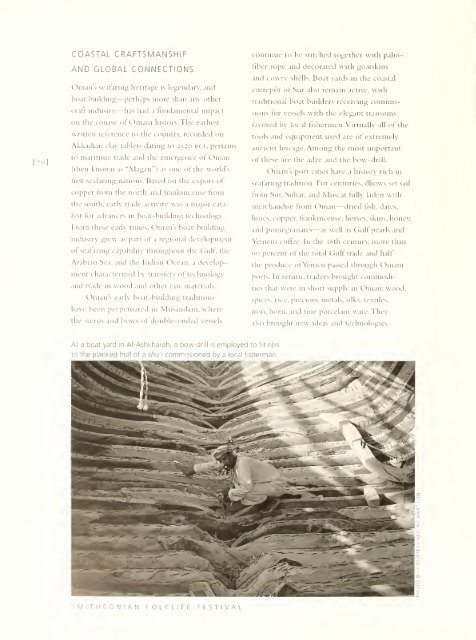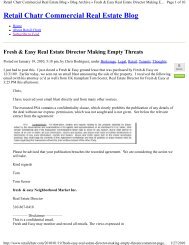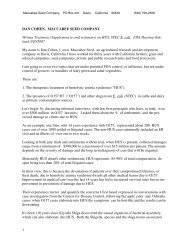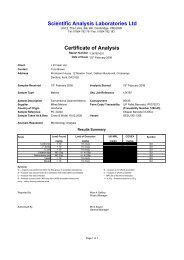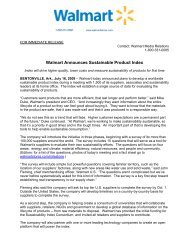70]COASTAL CRAFTSMANSHIPAND GLOBAL CONNECTIONSOman's seafaring heritage is legendary, andboat building— perhaps more than any othercraft industry—has had a fundamental impacton the course ot Omani history. The earliestwritten reference to the country, recorded onAkkadian clay tablets dating to 2520 BCE, pertainsto maritime trade and the emergence of Oman(then known as "Magan") as one ot the world'sfirstseafaring nations. Based on the export ofcopper from the north and frankincense fromthe south, earl} trade activity was a major catalysttor advances in boat-building technology.From these early times, Oman's boat-buildingindustry grew as part of a regional developmentot seafaring capability throughout the Gulf, theArabian Sea, and the Indian Ocean, a developmentcharacterized by transfers of technologyand trade in wood and other raw materials.Oman's early boat-building traditionshave been perpetuated inMusandam. wherethe sterns and bows ot double-ended vesselscontinue to lie stitched together with palmfiberrope and decorated with goatskinsand cowry shells. Boat yards in the coastalentrepot of Sur also remain active, withtraditional boat builders receiving commissionsfor vessels with the elegant transomsfavored by local fishermen. Virtually all of thetools and equipment used are of extremelyancient lineage. Among the most importantot these are the adze and the bow-drill.Oman's port cities have a history rich inseafaring tradition. For centuries, dhows set sailfrom Sur, Suhar, and Muscat fully laden withmerchandise from Oman—dried fish, dates,limes, copper, frankincense, horses, skins, honey,and pomegranates—as well as Gulf pearls andYemeni coffee. In the [8th century, more than(in percent of the total Gulf trade and halfthe produce ofYemen passed through Omaniports. In return, traders brought commoditiesthat were 111 short supply m Oman: wood,spices, rice, precious metals, silks, textiles,iron, horn, and tine porcelain ware. Theyalso brought new ideas and technologies.At a boat yard in Al-Ashkharah, a bow-drill is employed to fit ribsto the planked hull of a shu'i commissioned by a local fisherman.SMITHSONIAN FOLKLIFE FESTIVAL
[7i]A Bahía blacksmith, assisted by his sons, employs hot-forging techniques to make a steel knife blade.Many of the materials were importedto supply coastal cratt industries. Bronzeand iron contributed to the development otmetalworking — particularly tool making andweaponry production—while the gradual adoptionof silver and gold as regional currenciesencouraged the development of refined decorativetechniques tor weaponry and jewelry. Finehardwood brought a degree of sophisticationto the boat-building industry and permitted avolume of production that would have beenimpossible on the basis ot indigenous woodalone. The precious value of wood encouragedbeen gateways for new ideas, materials, andtechnologies, which have not only enriched thecratt heritage of coastal communities but alsofiltered inland via overland trade routes. At thesame time, Omani artisans, employing indigenousmaterials, techniques, and designs, havebrought their own interpretations and customsto the practice ot their crafts. The result is acaptivating synthesis, within which are discernibleArab, Asian, and East African influences.The resulting whole is a vibrant and uniquecratt culture that is resoundingly Omani.The souk in the capital city and port otthe development ot woodcarvmg into afineMuscat has a broader role than those in theart form that maintains its pride of place indoors, windows, and other decorative featuresof monumental and vernacular architecture.Embroiderers and pit-loom weavers benefitedfrom the import ot silk and other threads thatadd color and diversity to local costume.Towns such as Suhar, Muscat, Sur, andSalalah along Oman's coastline emerged as majorentrepots that boast a rich mixture of people,adecidedly cosmopolitan air, and a lively andvaried collection ot cratt traditions. They haveinterior. Although a center ot traditional craftsproduction, the souk also gathers cratt productsfrom all over the country—Bahla pottery,basketry from the Batinah, Sun embroidery andpit-loom weaving, tribal rugs and trappings, andNizwa copper and silverwork. All find an outletin the capital-area marketplace. Local women sellincense in the heart ot the souk, their mixturesspread before them to entice customers. Handembroideredqimmahs (men's caps), made inthe privacy ot the home or courtyard, are alsoOMAN DESERT, OASIS, AND SEA
- Page 1:
Smithsonianolklife Festival\Food Cu
- Page 4 and 5:
The annual Smithsonian Folklite Fes
- Page 7 and 8:
—CONTENTSThe Festival's Timely Ap
- Page 9 and 10:
—THE FESTIVAL'S TIMELY APPEALLAWR
- Page 11 and 12:
COMMERCE FOR CULTUREFrom the Festiv
- Page 13 and 14:
[ii]The food concession for the Mel
- Page 15 and 16:
oMiiitbioni.indotal SoundL04.A 1 Sl
- Page 17:
1WELCOME TO THE 2005 FOLKLIFE FESTI
- Page 20 and 21:
Workers harvest artichokes at Ocean
- Page 22 and 23: —assigned aparticular dish—meat
- Page 24 and 25: I--IPot Pie Farm manager Elizabeth
- Page 26 and 27: ISustainable farmers such as Eliot
- Page 28 and 29: "IThe numberof programsdesignedfor
- Page 30 and 31: .hadSALAD GREENS WITH GOAT CHEESE,
- Page 32 and 33: w.A>wm:~
- Page 34 and 35: —3 3]OCCUPATIONAL CULTUREThe 2005
- Page 36 and 37: employees, the USDA Forest Servicei
- Page 38 and 39: I[3 6]page book, which could fit in
- Page 40 and 41: ká.!i- .>!mKPA backpacker sets up
- Page 42 and 43: --^i'liunterw eight jihI ...itl jib
- Page 44 and 45: —4-"The essentialpiece isto captu
- Page 46 and 47: I44cutDUTCH OVENONE-POT MEALThomas
- Page 48 and 49: —FUTURE CONCERNS FOR PUBLIC LANDS
- Page 50 and 51: NUESTRA MÚSICA: MUSIC INBuilding C
- Page 52 and 53: plena groups throughout the Northea
- Page 54 and 55: NUESTRA MÚSICA LAUNCHES NEW SERIES
- Page 56 and 57: NUESTRA MÚSICA: MUSIC IN LATINO CU
- Page 58 and 59: "ILos Camperos de Valles son músic
- Page 60 and 61: RAICES LATINASNUESTRA MÚSICA LANZA
- Page 63 and 64: IOMAN: DESERT, OASIS, AND SEARICHAR
- Page 65 and 66: DESERTThe deserts ot the Arabian Pe
- Page 67 and 68: THE FESTIVAL PROGRAMThe 200s Smiths
- Page 70 and 71: 6 8The coiled, leather-covered bask
- Page 74 and 75: [72]Although the oldismaking way fo
- Page 76 and 77: AN OMANI FOLKTALEASYAH AL-BUALYOman
- Page 79 and 80: y%aMUSIC AND DANCE INOMANOMAN CENTR
- Page 81: In the southern Dhufar region, al-b
- Page 84 and 85: ecosystems, identification of plant
- Page 86 and 87: 2:00IIIVorkshopFESTIVAL SCHEDULE (P
- Page 88 and 89: Rhythm,Saturday, June 25 (Programs
- Page 90 and 91: )avidi nestMonday, June 27(Programs
- Page 92 and 93: 1:00IIlamFriday, July 1 (Programs a
- Page 94 and 95: )utchSunday, July 3(Programs are su
- Page 96 and 97: EVENING CONCERTSSounds of the Fores
- Page 98 and 99: theRELATED EVENTS[96]Nuestra Músic
- Page 100 and 101: IIDónalas Anderson,Washington, D.C
- Page 102 and 103: 'IEd LiíDmi, Studio City, Californ
- Page 104 and 105: ISudhir Seth, Bethesda, MarylandA g
- Page 106 and 107: 1 if 1 DumberHoneyBeehive Beeproduc
- Page 108 and 109: 1"''NewI >onI Lui\IDon Bustos,Espa
- Page 110 and 111: Ian Barlow, White Bird,Idaho; Woodl
- Page 112 and 113: I 'istnet1Gordon Grant,Corvallis, O
- Page 114 and 115: Kristen Marline, Flagstaff,Arizona;
- Page 116 and 117: I1 ountries,IIHistorie Site, once t
- Page 118 and 119: 1IworksI1 11Istations are vital to
- Page 120 and 121: 1'IenIpanderetas;JCJ Band. Washingt
- Page 122 and 123:
Ralph Rinzlersongs are "made" (or c
- Page 124 and 125:
I >cmseI VhorahII MiI lameEne Nance
- Page 126 and 127:
|i 2forIIBartlevy1 )oerr;IIParadeSP
- Page 128 and 129:
II AerialIIII1Washington and Jeffer
- Page 130 and 131:
Stack, Bill Stafford, loni Stafford
- Page 132 and 133:
SMITHSONIAN FOLKLIFE FESTIVAL 20051
- Page 135 and 136:
SMITHSONIAN FOLKLIFE FESTIVAL 2005B
- Page 138:
Smithsonian Folklife FestivalSMITHS


